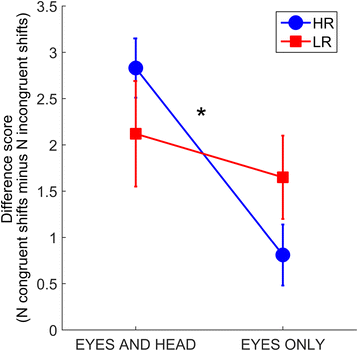Altered gaze following during live interaction in infants at risk for autism: an eye tracking study
- PMID: 26819699
- PMCID: PMC4729153
- DOI: 10.1186/s13229-016-0069-9
Altered gaze following during live interaction in infants at risk for autism: an eye tracking study
Abstract
Background: The ability to follow gaze is an important prerequisite for joint attention, which is often compromised in children with autism spectrum disorder (ASD). The direction of both the head and eyes provides cues to other people's attention direction, but previous studies have not separated these factors and their relation to ASD susceptibility. Development of gaze following typically occurs before ASD diagnosis is possible, and studies of high-risk populations are therefore important.
Methods: Eye tracking was used to assess gaze following during interaction in a group of 10-month-old infants at high familial risk for ASD (high-risk group) as well as a group of infants with no family history of ASD (low-risk group). The infants watched an experimenter gaze at objects in the periphery. Performance was compared across two conditions: one in which the experimenter moved both the eyes and head toward the objects (Eyes and Head condition) and one that involved movement of the eyes only (Eyes Only condition).
Results: A group by condition interaction effect was found. Specifically, whereas gaze following accuracy was comparable across the two conditions in the low-risk group, infants in the high-risk group were more likely to follow gaze in the Eyes and Head condition than in the Eyes Only condition.
Conclusions: In an ecologically valid social situation, responses to basic non-verbal orienting cues were found to be altered in infants at risk for ASD. The results indicate that infants at risk for ASD may rely disproportionally on information from the head when following gaze and point to the importance of separating information from the eyes and the head when studying social perception in ASD.
Keywords: Autism; Communication; Early development; Gaze following; Joint attention; Neurodevelopmental disorders; Social cognition; Younger siblings.
Figures


Similar articles
-
[Slowing down the flow of facial information enhances facial scanning in children with autism spectrum disorders: A pilot eye tracking study].Encephale. 2017 Feb;43(1):32-40. doi: 10.1016/j.encep.2016.02.005. Epub 2016 Mar 16. Encephale. 2017. PMID: 26995150 French.
-
Does decreased visual attention to faces underlie difficulties interpreting eye gaze cues in autism?Mol Autism. 2020 Jul 21;11(1):60. doi: 10.1186/s13229-020-00361-2. Mol Autism. 2020. PMID: 32693828 Free PMC article.
-
[Specifics of visual perception in infants with familial risk of autism spectrum disorders].Vestn Oftalmol. 2017;133(6):83-89. doi: 10.17116/oftalma2017133683-89. Vestn Oftalmol. 2017. PMID: 29319673 Russian.
-
Neurobiological Bases of Autism Spectrum Disorders and Implications for Early Intervention: A Brief Overview.Folia Phoniatr Logop. 2017;69(1-2):38-42. doi: 10.1159/000479181. Epub 2017 Dec 15. Folia Phoniatr Logop. 2017. PMID: 29248932 Review.
-
From gaze cueing to dual eye-tracking: novel approaches to investigate the neural correlates of gaze in social interaction.Neurosci Biobehav Rev. 2013 Dec;37(10 Pt 2):2516-28. doi: 10.1016/j.neubiorev.2013.07.017. Epub 2013 Aug 5. Neurosci Biobehav Rev. 2013. PMID: 23928088 Review.
Cited by
-
Interaction With Social Robots: Improving Gaze Toward Face but Not Necessarily Joint Attention in Children With Autism Spectrum Disorder.Front Psychol. 2019 Jul 5;10:1503. doi: 10.3389/fpsyg.2019.01503. eCollection 2019. Front Psychol. 2019. PMID: 31333540 Free PMC article.
-
Responding to Other People's Direct Gaze: Alterations in Gaze Behavior in Infants at Risk for Autism Occur on Very Short Timescales.J Autism Dev Disord. 2017 Nov;47(11):3498-3509. doi: 10.1007/s10803-017-3253-7. J Autism Dev Disord. 2017. PMID: 28871495 Free PMC article.
-
Social visual attention as a treatment outcome: evaluating the social games for autistic adolescents (SAGA) intervention.Sci Rep. 2024 Jan 5;14(1):619. doi: 10.1038/s41598-024-51332-z. Sci Rep. 2024. PMID: 38182792 Free PMC article.
-
Social attention to activities in children and adults with autism spectrum disorder: effects of context and age.Mol Autism. 2020 Oct 19;11(1):79. doi: 10.1186/s13229-020-00388-5. Mol Autism. 2020. PMID: 33076994 Free PMC article.
-
Visual Exploration of Dynamic or Static Joint Attention Bids in Children With Autism Syndrome Disorder.Front Psychol. 2019 Oct 9;10:2187. doi: 10.3389/fpsyg.2019.02187. eCollection 2019. Front Psychol. 2019. PMID: 31649576 Free PMC article.
References
-
- Tomasello M, Carpenter M, Call J, Behne T, Moll H. Understanding and sharing intentions: the origins of cultural cognition. Behav Brain Sci. 2005;28(05):675–91. - PubMed
-
- Gredebäck G, Theuring C, Hauf P, Kenward B. The microstructure of infants’ gaze as they view adult shifts in overt attention. Infancy. 2008;13(5):533–43. doi: 10.1080/15250000802329529. - DOI
Publication types
MeSH terms
LinkOut - more resources
Full Text Sources
Other Literature Sources
Medical

